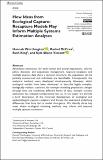Files in this item
How ideas from ecological capture-recapture models may inform multiple systems estimation analyses
Item metadata
| dc.contributor.author | Worthington, Hannah | |
| dc.contributor.author | McCrea, Rachel | |
| dc.contributor.author | King, Ruth | |
| dc.contributor.author | Vincent, Kyle | |
| dc.date.accessioned | 2020-12-23T16:30:02Z | |
| dc.date.available | 2020-12-23T16:30:02Z | |
| dc.date.issued | 2020-12-07 | |
| dc.identifier | 271010955 | |
| dc.identifier | 95a3c986-b2d3-4b93-9c18-8533390e5c6a | |
| dc.identifier | 85097314605 | |
| dc.identifier | 000624201000001 | |
| dc.identifier.citation | Worthington , H , McCrea , R , King , R & Vincent , K 2020 , ' How ideas from ecological capture-recapture models may inform multiple systems estimation analyses ' , Crime and Delinquency , vol. OnlineFirst . https://doi.org/10.1177/0011128720974319 | en |
| dc.identifier.issn | 0011-1287 | |
| dc.identifier.other | ORCID: /0000-0001-5452-3032/work/85855233 | |
| dc.identifier.uri | https://hdl.handle.net/10023/21194 | |
| dc.description.abstract | Abundance estimation, for both human and animal populations, informs policy decisions and population management. Capture-recapture and multiple sources data share a common structure; the population can be partially enumerated and individuals are identifiable. Consequently, the analytical methods were developed simultaneously. However, whilst ecological models have been developed to describe highly complex, biologically realistic scenarios, for example modeling population changes through time and combining different forms of data, multiple systems estimation has changed comparatively less so. In this paper we provide a brief description of the historical development of ecological and epidemiological capture-recapture and discuss the associated underlying differences that have led to model divergence. We identify three key areas where ecological modeling methods may inform and improve multiple systems estimation. | |
| dc.format.extent | 17 | |
| dc.format.extent | 217021 | |
| dc.language.iso | eng | |
| dc.relation.ispartof | Crime and Delinquency | en |
| dc.subject | Behavioral effects | en |
| dc.subject | Integrated modeling | en |
| dc.subject | Multi-state modeling | en |
| dc.subject | Temporal data | en |
| dc.subject | QH301 Biology | en |
| dc.subject | QA Mathematics | en |
| dc.subject | T-NDAS | en |
| dc.subject.lcc | QH301 | en |
| dc.subject.lcc | QA | en |
| dc.title | How ideas from ecological capture-recapture models may inform multiple systems estimation analyses | en |
| dc.type | Journal article | en |
| dc.contributor.institution | University of St Andrews. Statistics | en |
| dc.contributor.institution | University of St Andrews. Centre for Research into Ecological & Environmental Modelling | en |
| dc.identifier.doi | 10.1177/0011128720974319 | |
| dc.description.status | Peer reviewed | en |
This item appears in the following Collection(s)
Items in the St Andrews Research Repository are protected by copyright, with all rights reserved, unless otherwise indicated.

